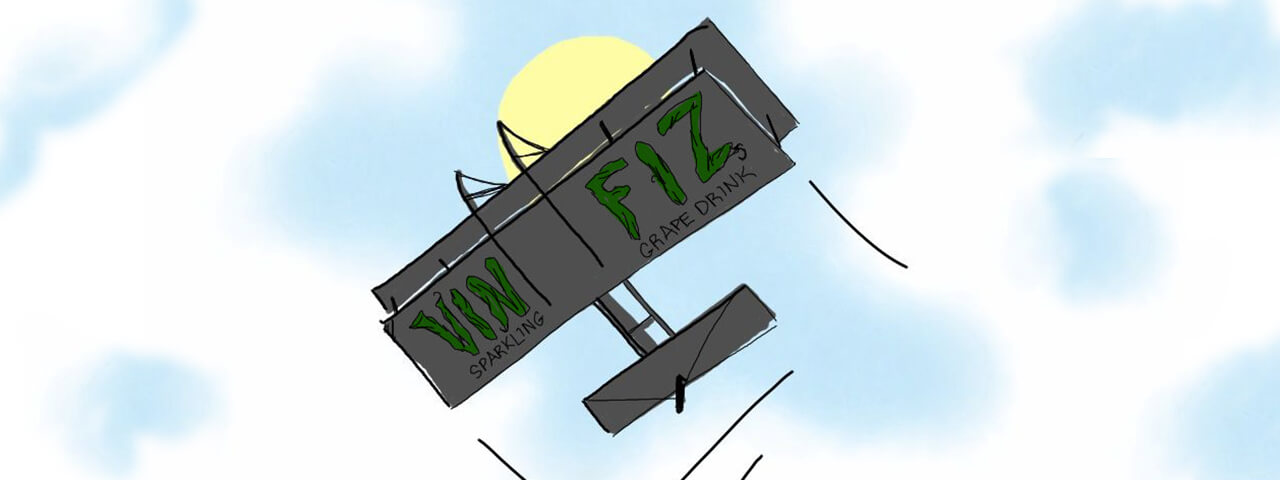In 1911, the publisher, William Randolph Hearst made an offer of $50,000 to the first person who could fly a plane from LA to New York or New York to LA in under 30 days from start to finish. Calbraith “Cal” Perry Rodgers took up the challenge.
Cal’s Challenge and Sponsorship
Of course, Cal didn’t have any money. He won the plan in a contest, but in the “good ‘ole days” an airplane required a very large support crew. So, he started talking to businesses about possible sponsorships. Cal was able to secure a sponsorship from Armour and Company for the 1911 Wright Flyer that was to make the trek across the United States. Amour and Company had created a new grape soft drink called Vin Fiz.
Birth of the Vin Fiz Flyer
The Vin Fiz Flyer was born. Emblazoned with the logo for Vin Fiz and messages of Drink Vin Fiz and Ideal Grape Drink, Cal began his journey across the North America beginning from Sheepshead Bay, New York on September 17, 1911. Not to be outdone, the all cars of the train, paid for by Armor and Company, also sported messages of Drink Vin Fiz.
The Drink’s Disappointing Reality

Of course, none of this changed the fact that the grape soda, advertised as the “Sparkling Grape Drink” did not even come close to living up to it’s purported luster.
Comments that really described the joy of drinking Vin Fiz were:
"Tastes like a cross between river water (sludge) and horse slop"
"It has a laxative effective"
And my favorite, "You have to sneak up on it to get it down."
A Journey Marked by Crashes
Over the course of the next 56 days, Cal seemed more to crash his way across the country than fly. He crashed so significantly that there were only a very few number of parts of the plane left when he finally made it to LA.
On November 12th, 1911, Cal took off from Pasadena, California in front of a crowd of some 20,000 people (all recognizing the Vin Fiz logo) but a crash in Compton gave him a brain concussion and a twisted spine. He spent three weeks in the hospital recovering and finally finished his journey in Long Beach, California on December 10, 1911 (54 days after he no longer qualified for the prize) and only about 82 hours in the air.
Cal’s Reward and Tragic End
On top of the prestige of being the first person to fly across North America, Cal was paid $23,000 by Armor and Company for the effort. Even though he didn’t win the prize of $50,000, he at least was paid well for the effort. To put that number into perspective. The median household income in 1985 was a little over $23,000.
Unfortunately, a few months later, Cal was taking a test flight in Long Beach, not far from the end of his historic flight and flew into a flock of seagulls and crashed in the Pacific Ocean breaking his neck and dying.
The Legacy of Vin Fiz
The question that ensues from this story is, “What happened to Vin Fiz?”
It simply went away.
The amount of money put into launching the product and advertising the “Sparkling Grape Drink sold at all Soda Fountains” never really took off (yeah, I get the pun). No one liked it. They all knew about it but it tasted so bad that people didn’t buy much.
Search the internet today and you’ll find site after site on the Vin Fiz Flyer. In fact the Vin Fiz Flyer is immortalized in the Smithsonian Air and Space Museum. Multiple books talk about the Vin Fiz Flyer but there is little said about Vin Fiz Grape Drink.
No amount of money spent will overcome a bad brand. No matter how much brand awareness you get, no matter how many people know about you or your business, you will never overcome the problems inherent with a bad product or service.
Your Web presence is no different. Your Web presence is an amplifier of who you are. If you try to hide who you are, it will only come back to haunt you.
Brand Awareness: More Than Just Noise
Brand awareness is about getting your name out there, but it’s not a cure-all. The Vin Fiz Flyer plastered its logo across America, yet the drink flopped because it couldn’t deliver on taste. Your website is your primary tool for building awareness, but it’s only as effective as the brand behind it. A weak product or service, no matter how well-known, will crash when customers experience it firsthand.
Why does this happen? Awareness campaigns—whether through bold logos on a plane or slick digital ads—create expectations. If your product doesn’t meet those expectations, you’re not just wasting money; you’re damaging trust. Customers today are relentless. They’ll share their disappointment on X, leave scathing reviews on Google, or ghost your brand entirely. Your website, as the hub of your digital presence, either reinforces a strong brand or exposes a weak one.
The Risks of Empty Awareness
Pumping money into brand awareness without a solid foundation is like Cal flying a plane with half its parts missing. It might get off the ground, but it’s not going far. Businesses face a dizzying array of awareness tools: TikTok campaigns, influencer partnerships, AI-driven ads, programmatic billboards. These can generate buzz, but they also magnify flaws. A client once told me about a competitor who spent thousands on a viral video campaign, only to see it backfire when customers realized the product was subpar. The web amplified their failure, not their success.
The Vin Fiz story shows this in stark relief. Armour’s investment made everyone aware of the drink, but its “laxative effect” ensured nobody wanted it. Your website does the same. If your service is shoddy or your product is a dud, no amount of SEO, sleek design, or social media hype will save you. Customers will taste the “horse slop” and walk away.
Building Awareness That Lasts
So, how do you make brand awareness work? Start with a product or service worth shouting about. Then, use your website to amplify that quality authentically. Here’s how:
- Test Your Offering Rigorously: Before launching a campaign, get honest feedback from real customers. Fix flaws early, so your website isn’t amplifying problems.
- Align Content with Reality: Your site’s messaging must match what you deliver. Don’t promise a “Sparkling Grape Drink” if you’re serving sludge.
- Track Perceptions Online: Use Google Analytics or AI sentiment tools to monitor how customers view your brand. If they’re spitting out your Vin Fiz, adjust fast.
- Craft Authentic Stories: Share testimonials, case studies, or anecdotes that prove your value. Make your site a conversation, not a sales pitch.
The Vin Fiz story stands as a cautionary tale.
Your Website: A Mirror, Not a Mask
Your website is your Vin Fiz Flyer, soaring across the digital sky. It’s often the first touchpoint for customers, amplifying your brand. A strong brand, backed by quality, can leverage mobile-first design, smart SEO, and engaging content to build lasting awareness. But a weak brand will be exposed, no matter how flashy your site. The Vin Fiz Flyer made history, but the drink it advertised is a footnote. Your website will tell your story—make sure it’s one worth telling.
Take a look at your site. Does it amplify a brand you’re proud of, or is it masking a product that’s less than sparkling? A bad brand can’t hide behind a pretty web presence any more than Vin Fiz could hide its taste behind a bold logo. Your site is a mirror, not a mask.
Amplify a Brand Worth Celebrating
The Vin Fiz Flyer’s story is a wake-up call for every SMB owner, marketer, or entrepreneur. Brand awareness is a powerful tool, but it’s only as good as the product behind it. Your website, as the heart of your digital presence, must amplify a brand worth celebrating. Before you chase the next viral campaign or AI ad blitz, ensure your offering is something customers will love—not something they’ll spit out.
Jul 17, 2025 10:24:00 AM
Ready to simplify and succeed? Let’s make it happen—because your business deserves practical, no-nonsense wins. Find me on LinkedIn.


